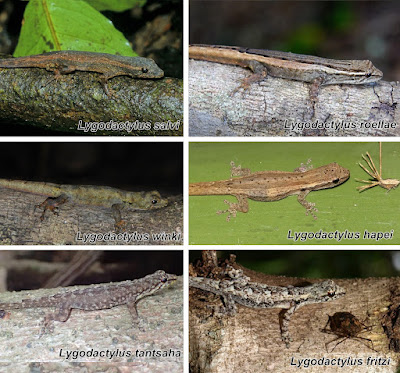 |
| Lygodactylus spp. Vences, Multzsch, Gippner, Miralles, ... et Scherz, 2022 |
Abstract
The Lygodactylus madagascariensis species group, constituting the subgenus Domerguella, currently contains five valid species of inconspicuous dwarf geckos from Madagascar’s humid forests, but at least 18 deep genetic lineages have been revealed by recent molecular studies. Given the high morphological similarity of these lineages, taxonomic resolution of this astonishing diversity requires efforts to correctly delimit species, as well as assigning the available nomina to the species-level lineages identified. We here combine DNA sequences of one mitochondrial and two nuclear-encoded gene fragments with morphometric measurements and scale counts, and report evidence for a species status of most of the previously identified lineages. In particular, we rely on sympatric and often even syntopic occurrence of several of these lineages without evidence for genetic admixture, and consistent with subtle morphological differences. Furthermore, the very high divergences of 7.4–23.8% pairwise distances in the relatively conserved mitochondrial 16S rRNA gene, combined with a lack of haplotype sharing in the nuclear-encoded genes and differences in scale counts convinced us that most of the other, allopatrically distributed lineages also represent distinct species. We elevate L. madagascariensis petteri to species level and formally name eight new species: L. salvi sp. nov., a species from the Sambirano region in northern Madagascar, previously called L. sp. 8; L. tantsaha sp. nov. (L. sp. 10), a species occurring sympatrically with L. madagascariensis and L. petteri on Montagne d’Ambre in far northern Madagascar; L. roellae sp. nov. (L. sp. 17), a species characterized by a striped coloration in all known specimens, from northern Madagascar; L. winki sp. nov. (L. sp. 18), an unstriped species from northern Madagascar but belonging to a subclade mostly distributed in the eastern rainforests of the island; L. ulli sp. nov. (L. sp. 21), a species from the same subclade as L. winki but known only from the Marojejy Massif in the North East; L. fritzi sp. nov. (L. sp. 11), a further species of this subclade from coastal lowlands in the Northern Central East; L. hodikazo sp. nov. (L. sp. 23) known from a single specimen collected at the Tsingy de Bemaraha and therefore the only Domerguella species known from the West region of Madagascar; and L. hapei sp. nov. (L. sp. 26), an enigmatic species from the Sambirano region characterized by a striped pattern on the throat that is otherwise unknown in the subgenus. Three additional deep mitochondrial lineages of Domerguella were identified in our analysis, but could not be further analyzed due to the lack or scarcity of voucher specimens. More field work and collection of voucher specimens is needed to understand their status. Furthermore, the taxonomy of the Domerguella subclade occurring in eastern Madagascar, with three described species (L. guibei, L. miops, L. fritzi), two synonyms (L. septemtuberculatus, Microscalabotes spinulifer) and at least two further deep genetic lineages co-occurring in a relatively small area, requires further revisionary work, possibly aided by target-enrichment sequencing of the respective name-bearing types.
Keywords: Squamata, Gekkonidae, Domerguella, dwarf geckos, cryptic species, integrative taxonomy
Systematic accounts
• Lygodactylus expectatus Pasteur & Blanc, 1967
Etymology: From Latin expectatus = expected. As explained in the original description, G. Pasteur and C.P. Blanc were expecting to find a new species in the karstic regions of the Ambilobe region.
• Lygodactylus rarus Pasteur & Blanc, 1973
Etymology: derived from Latin rarus (rare, unusual).
• Lygodactylus miops Günther, 1891
Etymology: From Latin (originally Greek) miops = short sighted and probably referring to the large eyes of the species highlighted in the original description. Identity and Diagnosis. Our data show the presence of five genetic lineages in the general area of
• Lygodactylus madagascariensis (Boettger, 1881)
• Lygodactylus petteri Pasteur & Blanc, 1967
• Lygodactylus guibei Pasteur, 1965
• Lygodactylus hodikazo sp. nov.
Etymology. The species epithet is derived from the Malagasy words hodi-kazo (= tree bark), in reference to the habitat of most Domerguella (and supposedly also this species) who are typically found on trees in forest and with a color pattern mimicking the bark. The name is used as noun in apposition.
• Lygodactylus tantsaha sp. nov.
Etymology. We are pleased to dedicate this species to Aaron M. Bauer in recognition of his extraordinary
work fostering our knowledge about gecko diversity, biology, and evolution. The species name is derived from the
Malagasy word tantsaha = farmer, in allusion to the original root of Aaron’s surname Bauer (German) = farmer.
Coincidentally, individuals assignable to this species were found at the edge of an area of illegal farming within the
park on the west slope, giving the name a second local meaning.
• Lygodactylus salvi sp. nov.
• Lygodactylus roellae sp. nov.
• Lygodactylus hapei sp. nov.
• Lygodactylus winki sp. nov.
• Lygodactylus ulli sp. nov.
• Lygodactylus fritzi sp. nov.
Miguel Vences, Malte Multzsch, Sven Gippner, Aurélien Miralles, Angelica Crottini, Philip-Sebastian Gehring, Andolalao Rakotoarison, Fanomezana M. Ratsoavina, Frank Glaw and Mark D. Scherz. 2022. Integrative Revision of the Lygodactylus madagascariensis Group reveals An Unexpected Diversity of little Brown Geckos in Madagascar’s Rainforest. Zootaxa. 5179(1); 1-61. DOI: 10.11646/zootaxa.5179.1.1

